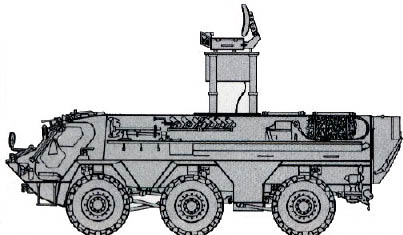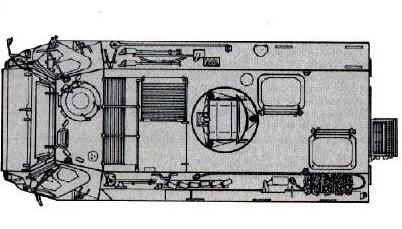Le TpZ1 Fuch RASIT
English Translation

Dès 1970 Daimler participait au programme du développement du TPz qui avait été lancé dans les années soixante .En 1973, les prototypes sortent et en 1977 commence la livraison en corps de troupes a . Les livraisons vont atteindre le chiffre de plus de 1000 véhicules. Le Fuchs possède une caisse en acier soudée protégée NRBC. Il possède une caisse avec 6 m3 de charge Utile Le Fuchs est un véhicule amphibie qui se déplace sur l’au à la vitesse de 10 km/h grâce à 2 hélices. Il existe 7 versions de base du A1 au A7. Mais ces versions se déclinent souvent en des versions spécifiques pour telles ou telles missions comme NRBC le génie la guerre électronique. La version qui nous intéresse ici est la version RASIT ou véhicule radar (Radar de Surveillance des Intervalles ) Les français possèdent un système similaire complété par le RATAC( http://www.maquetland.com ) voyons maintenant ce véhicule qui nous intéresse
Le TPz 1Fuch RASIT
Ce véhicule possède les mêmes caractéristiques que le TPZ de base mais la partie réservée au transport de troupe été modifiée pour servir au la tache qui lui a été dévolue la détection des intrusions dans un rayons de 20 Kms
Les RASIT-Fuch sont apparus dans la Bundeswehr dans les années 80 aux seins des PzAufklBtl ( Bataillon de Reconnaissance Blindé ) 0 l’image des escadrons d’éclairage Divisionnaire des nos DB (EED ) des années 75 . Ces engins étaient montés sur des châssis type les SPz, ou sur des camions de 5t Iltis
le TPz PARA RASIT a été commandé en 1986 à 110 véhicules (type DR-PT-2a). Il a un équipage de 4 hommes qui dispose d’un vaste environnement de travail
En effet dans le volume arrière se trouvent disposer les outils de travail. Table de travail installation radio informatique
Le poids de l’engin est de 17 tonnes
.jpg)
Le système RASIT
Le système RASIT-E est un radar très perfectionné (type DR-PT-2a) pour la surveillance du champ de bataille et du contrôle des tirs d’artillerie. Il travaille sur une bande longue
(40 mi) et permet la détection l’acquisition la localisation et ‘identification des cibles terrestres en mouvement. Ces coordonnées sont ensuite transmises aux unités d’artillerie pour traitement. Le système RASIT E est disponible en 3 version Portable à dos d’homme, monté sur un véhicule léger ou dans un shelter
Il utilise les effets Doppler du radar et travaille en I band. En 10 secondes l’opérateur entraîné pour identifier sa cible et 30 secondes après celle-ci est localisée et identifiée. Il peut aussi en cas de tir d’artillerie corriger ceux-ci
Le système allemand est donc transporté dans un châssis Fuchs Le radar est monté sur un mat télescopique rétractable à l’intérieur du véhicule grâce à des vérins hydrauliques (hauteur 4.5m). Il permet une surveillance du champ de bataille sur une distance de 20 Kms. Il détecte les personnes jusqu’à 6 Kms et les véhicule jusqu’à 20 Kms .Le radar peut être enlevé du véhicule pour être déplacé à une certaine distance de celui-ci L’alimentation en énergie est alors fournie par un équipement qui se trouve placé dans la porte arrière gauche du véhicule (5kW SEA), ce qui donne à l’engin un silhouette de Fuchs NRBC À côté des coffres sur le toit de l engin on trouve aussi un enrouleur de câble utile lorsque le système est déployé hors de l engin (5 kWe SEA)
Chaque compagnie d’éclairage possède 3 véhicules.
Dans l’ancienne structure de la Bundeswehr les PzAufklKp des brigades ont possédé un PzAufklZg (peloton Z pour Zug ) lourd avec 3 TPz 1 Fuchs RASIT assistés de 4 TPz1 radio ou protection
Dans la nouvelle organisation les bataillons d'éclairage blindés ne seront plus disponibles qu’au niveau du corps d’armée. Ils sont alors formés de 3 compagnies d’éclairage blindée (PzAufklKp) composées de 12 TP1 Fuchs 3 TPz1 Rasit et 1 TPz 1 Fuchs radio
Merci a Thomas Hartwing pour le pret des photos :http://www.panzer-modell.de
TpZ1 1Fuch RASIT

Since 1970 Daimler took part in the program of the development of TPz which had been launched in the Sixties
In 1973, prototypes leave and in 1977 the delivery in regiments starts .
The deliveries will reach a total of more than 1000 vehicles.
Fuchs has a weld steel frame protected NRBC with 6 m3 of payload Fuchs is an amphibious vehicle which moves on with at the speed of 10 km/h thanks to 2 propellers. There are 7 initial versions of A1 in A7.
But these versions are often declined in specific versions for such or such missions like NRBC the enginers corps, the electronic war. The version which interests us here is version RASIT or vehicle radar (Radar Surveillance (Watch) des Intervalles)
French has a similar system supplemented by the RATAC(http://www.maquetland.com)
Now see this vehicle which interests us TPz 1Fuch RASIT
The TPz 1Fuch RASIT
This vehicle has the same characteristics as the basic TPZ but the part reserved normaly for the transport of the troop his modified to be used for the job which was reserved so , the detection of the intrusions in a radius of 20 Kms
RASIT-Fuch appeared in Bundeswehr in the Eighties in the PzAufklBtl (Battalion of Recognition Armoured) like the squadrons of Eclairage Divisionnaire of our old DB (EED) . These machines were assembled on standard frames SPz, or on trucks of 5t Iltis
The TPz PARA RASIT was ordered in 1986 to 110 vehicles (type Dr.-Pt-2a).
It has a crew of 4 men which has a vast environment of work
The back volume of the frame is dedicate for this mission.Working tools, Work table installation the radio data-processing
The weight of the machine is 17 tons
.jpg)
The RASIT System
This RASIT system (system RASIT-E )is a very sophisticated radar (type Dr.-Pt-2a) for the monitoring of the battle field and the control of the artillery shootings. It works on a long tape (40 mi) and allows the detection, acquisition ,localization and identification of the lands targets The coordinates are then transmitted to the units of artillery for treatment.
RASIT E system is available into 3 versions
Portable version to back of man,
On a light vehicle or in a shelter
Or un Armoured Vehicle
It uses the Doppler effects of the radar and works out of I band. In 10 seconds the operator trained to identify his target and 30 seconds after this one is located and identified.
He can also in the event of shooting artillery correct those
the German system is transported in a Fuchs frame . The radar is assembled on a retractable telescopic mast inside the vehicle thanks to hydraulic jacks (height 4.5m).
He allows an inspection of the battle field at a distance of 20 Kms.
He detects the people up to 6 Kms and the vehicle up to 20 Kms
The radar can be removed of the vehicle and moved at a certain distance of this own energy supply witch is provided by equipment which is placed in the lest rear door (5kW SEA), which gives to the machine a silhouette of Fuchs NRBC
On the roof of the Tpz uou find also a roller of useful cable when the system is deployed out of the machine (5 kWe SEA)
Each company of recce has 3 vehicles. In the old structure of Bundeswehr Brigades PzAufklKp had a heavy PzAufklZg (group Z for Zug) of 3 TPz 1 Fuchs RASIT assisted of 4 radio operator TPz1 or protection.
In the new organization the recce armoured battalions will be more available only to the level of the army corps.
They then are made of 3 recce armoured companies (PzAufklKp) with 12 TP1 Fuchs 3 TPz1 Rasit and 1 TPz 1 Fuchs radio operator

Thanks to thomas hartwig for his autorisation to publicate this pics http://www.panzer-modell.de







.jpg)